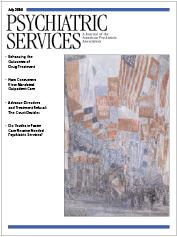Mad Yankees: The Hartford Retreat for the Insane and Nineteenth-Century Psychiatry
Mad Yankees: The Hartford Retreat for the Insane and Nineteenth-Century Psychiatry details the formative years (1824 to 1868) of the Hartford Retreat for the Insane (now the Institute for Living) through examination of the professional lives and times of its first superintendent, Eli Todd, and a number of his successors—in particular, Amariah Brigham and John S. Butler. These men were all early proponents of "moral care," which disavowed the use of shackles, chains, and dungeons and the perception of the insane as incurable, in favor of benevolent supervision and the goal of curing the acutely ill and providing long-term, humane care for the chronically ill. The retreat was founded by practitioners of moral care, and its history chronicles the dawn of modern psychiatry.
In Mad Yankees, author Lawrence B. Goodheart argues that the medical and psychiatric practices of the retreat's founders were strongly motivated by civic duty, Christian stewardship, and belief in individual responsibility for salvation (and in turn, sanity). His thesis situates this story within the complex social milieu of the second great awakening and the age of Jackson, when religious revivals elicited overwrought fits of devotion, benevolent societies abounded, and the common (white) man gained political and economic ground. Goodheart argues against the conclusions of Foucault's Madness and Civilization (1965) and Rothman's Discovery of the Asylum (1971), which contend that the development of asylums and asylum medicine was motivated by the establishment's desire for social control. Rather, he asserts, "Neither entirely medical nor exclusively punitive, the mental hospital was shaped by humanitarian concerns as well as hegemonic conventions."
The book is organized into an introduction and six chapters, followed by a short epilogue. The introduction establishes the academic context of arguments about the general history of asylum medicine. The first chapter sets the historical context, detailing the post-Revolution history of Connecticut, the strong links between clergy and physicians during the early 19th century, the common medical practices of the times—for example, blood letting and blistering—and the fiscal and legislative environment of Connecticut that set the scene for the financial hurdles the retreat's founders overcame in bringing it to fruition, and suffered with through its history.
Subsequently, the author interleaves chapters about the more influential of the retreat's early superintendents with chapters on "The Paradox of Curative Treatment" and "The Impoverished Insane." The biographical chapters about Todd, Brigham, and Butler chronicle the medical culture and practices of the times, the strong European influences—that is, the work of Phillipe Pinel and the Tuke family—on their adoption of moral care as well as their personal histories, and successes and failures at the retreat. Of particular note are Todd's claims of suspiciously high cure rates, Brigham's early work in neuropsychiatry, and Butler's success in moving the retreat forward in times of its greatest financial stress.
In the two nonbiographical chapters, Goodheart provides a window into the workings of the retreat through patient data and annual reports, letters from patients to family members (and vice versa), letters from family members to physicians, and petitions for treatment by the needy to the state government. Some major themes of these chapters are the biased view that women were more prone than men to insanity (well illustrated through copious letters and descriptions of treatment); societal and religious norms in identification and diagnosis of mental illness—for example, the belief that masturbation causes insanity; and the public health crisis faced by the state mid-century. Here Goodheart's thesis gains focus, as his accounting of patients and their care demonstrates the strong religious beliefs of the retreat's superintendents—however secularized they might have been—and their emphasis on personal salvation and self-control as curative.
Paramount in the promotion of moral care was the claim of high cure rates. As the physicians of the retreat recognized greater success with the acutely ill, the chronically ill were less frequently admitted. And given that the indigent insane were less likely to receive early care, they inexorably grew in numbers, both within the retreat and at large. Eventually, after the retreat had struggled for decades to meet the needs of the state's poor, in 1868 the state of Connecticut opened its first public asylum, the Connecticut Hospital in Middletown (now Connecticut Valley Hospital). Finally free of the burden of supporting the indigent through increasing fees for wealthier patients, the Hartford Retreat gained its long-sought fiscal balance and original mission as an asylum for the elite.
Closing the book is the epilogue, "The Emergence of Eugenics," a fascinating—but far too short—summary of the deterioration of the philosophy and practice of moral care as second-tier public asylums such as Connecticut Hospital faced a growing public health crisis. Incredibly, by 1900 the hospital housed 2,000 patients. The homelike atmosphere prescribed by moral care was replaced with warehousing in large dormitories and the curtailment of therapy. The state sought preventive measures to reduce the numbers of the chronically insane—new eugenics legislation limited the marriage rights of the feeble-minded and even paupers and outlawed fornication among such individuals. The contrast with moral care is dramatic. The book harshly documents the historical progression from the ethnically homogeneous, bucolic Connecticut of the early 19th century, dotted with small towns and farmland, to one scarred by industrialization, large cities, and slums and teeming with new immigrants and new bigotries.
Mad Yankees is not "light reading" but a detailed academic work thoroughly referenced with endnotes and an index of names and terms. The book will be of interest to students of the history of 19th-century American culture, the history of psychiatry, and the history of medicine.
Dr. West is affiliated with Wesleyan University in Middletown, Connecticut.



